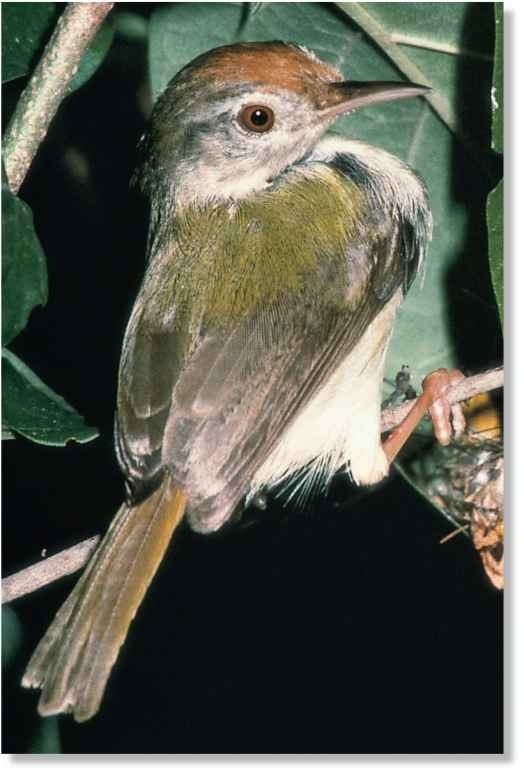ORDER
Passeriformes
FAMILY
Sylviidae
GENUS & SPECIES
key features
• An abundant insecteater that is as at home in an urban
vegetable patch as in the undergrowth of a forest clearing
• Stitches leaves together to form a pouch, in which it builds its nest hidden from predators
• The constant call between male and female is a characteristic sound of southeastern Asia
where in the world?
Found across southern China, southeastern Asia, the Malay Peninsula and Java; also throughout the indian subcontinent, including Sri Lanka

Lifecycle
The tailorbird owes its name to the female’s extraordinary sewing skills. Using her bill as a needle, she stitches one or more leaves into a pouch to form the basis of the nest.
HABITAT
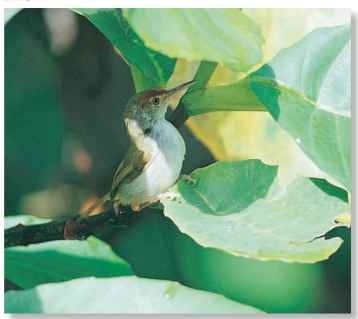
A Bird in the bush The tailorbird lives in undergrowth that springs up in forest clearings.
The common or long-tailed tailorbird is a familiar sight throughout its extensive range. It even thrives in urban gardens and parks, where it hunts and skulks in hedges, flowerbeds and tangled shrubbery
The common tailorbird is adaptable, taking advantage of any dense vegetation, including forest clearings. It is also found in semi-desert scrublands and in clumps of bamboo woodland at altitudes of up to 6,000′, provided that there is cover for nesting.
Despite its efforts to hide its nest, the tailorbird is often the victim of cuckoos, which lay their eggs in the tiny nests.
The common tailorbird often steals fibers from house doormats, which it then uses to stitch up its nest pouch.
BEHAVIOR
Seemingly tireless, the common tailorbird hops actively among bushes, hedges and trees in its ceaseless search for tiny insects, its tail cocked high above its back and wagging from side to side.
The bird’s weak, erratic flight makes it an easy target for flying predators. Therefore, it flits swiftly from one patch of undergrowth to another; avoiding open areas. However; where the tailorbird inhabits areas near human settlements, it is surprisingly tame.
A tailorbird pair forms a long-term bond and lives within a static territory all year. The birds remain in constant contact with each other, uttering a surprisingly loud, monotonous call: chee-up, chee-up.When danger threatens, such as the appearance of a shikra — the common small sparrowhawk of southern Asia — the pair makes noisy alarm calls of pit-pit-pit until the danger has passed.
BREEDING
The tropical undergrowth where the tailorbird lives teems with nest robbers, such as snakes, lizards, mongooses and various predatory birds. To avoid these predators, the tailorbird constructs its nest deep in a thicket or tree up to 20′ high.
Pairs usually breed between February and May. After mating, the female begins the arduous work of nest-building. It takes her up to two days to stitch the pouch together, while the male defends the pair’s territory from other tailorbirds. Once the pouch is complete, the male helps her construct the nest from grasses, and then line it with cotton, feathers and animal hairs.
Both parents incubate the clutch, and later bring food to the nestlings — an exhausting task that occupies them constantly until the chicks are fledged two weeks later.
Safety pouch The nest leaves provide excellent camouflage.
GETTING STITCHED UP

1 Tailor maid…
Selecting a large leaf in the middle of a bush, the female carefully brings the two edges together to form a pouch.
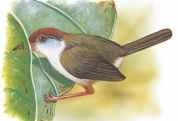
2 Needlework…
Using her long, thin bill like a hole puncher, the female deftly jabs a line of small, precise holes along the edges of each side of the leaf.
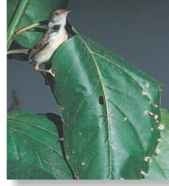
A Constant fidget This restless, inquisitive bird is always on the move.
CONSERVATION
Widespread in its range, the common tailorbird readily adapts to human habitation and benefits from jungle clearance, a process detrimental to many other animals. But clearance of scrubby undergrowth may cause declines in some areas.
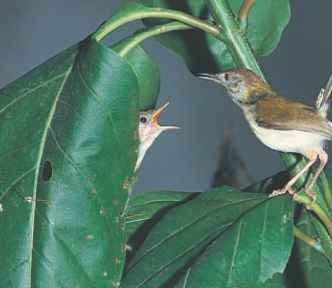
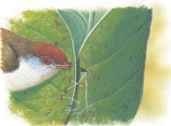
3 sew sew good…
The bird pushes binding material, such as plant fibers and spider silk, through the holes, drawing the edges of the leaf together.

4 Hanging basket
The ends of the stitching fray naturally into bunches, making a solid cradle in which both parents build the tiny nest.
FOOD & FEEDING
Like most warblers, the tailorbird feeds on insects and other small invertebrates that abound in its tropical habitat. Creeping in the undergrowth, it uses its bill like a pair of forceps to pick off beetles, bugs, caterpillars and spiders from leaves, stems and branches. The bird is also able to reach deep into flowerheads and drink the sugary nectar
Swarms of flying termites provide food for many birds, and are particularly abundant in the rainy season. The tailorbird, being a less adept flier, must wait until the creatures land and shed j their wings before gorging itself. Such gluts are essential to feed chicks, and may enable more young to survive to adulthood.
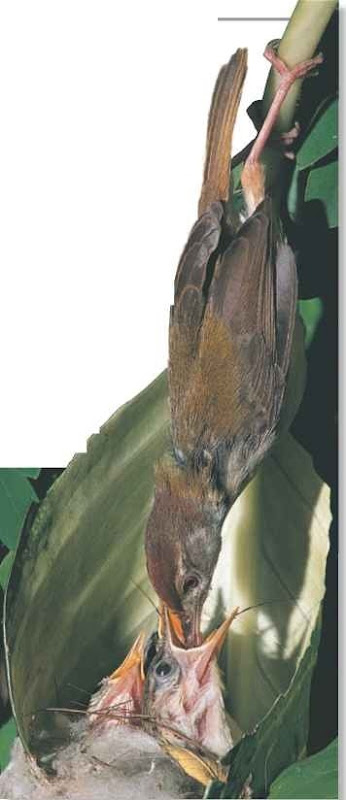
Gulp Young battle for every scrap.
PROFILE
Common Tailorbird
Brown and olive-green plumage conceals the common tailorbird as it hunts tirelessly in undergrowth for food.

CREATURE COMPARISONS
The long-billed forest tailorbird, Orthotomus moreaui, is one of two tailorbird species in eastern Africa.This rare bird exhibits the same nest-building skills as the rest of the genus. Similar in shape and size to the common tailorbird, and with an equally long tail, this warbler is mainly grayish-brown above and paler below. Rarely found near humans, it lives at altitudes between 2,500-3,500′ in restricted parts of the Usumbara Mountains
and Njesi Plateau of Tanzania. Like its Asian cousin, the long-billed forest warbler skulks in
dense undergrowth using its needlelike bill to Common ^ rv ^Long-billed
tailorbird /J Slean lnsects from stems and the undersides of leaves. tailorbird

| vital statistics | |
| Weight | 0.4 oz. |
| Length | 5-7″ |
| WlNGSPAN | 5-5.5″ |
| Sexual Maturity | 1 year |
| Breeding Season | All year; peaks from February-May |
| Number of Eggs | 3-5 |
| Incubation PERiOD | 12 days |
| Fledging Period | 12-13 days |
| Breeding Interval | 1 year |
| Typical Diet | Insects and spiders; rarely nectar from flowers |
| Lifespan | Unknown |
Related species
• The common tailorbird is 1 of 11 species in the genus Orthotomus.Of these, 9 occur in southeastern Asia and 2, the forest warblers, are found in East Africa. Orthotomus is 1 of 67 genera in the family Sylviidae. Most of these species are Old World warblers — small, insect-eating birds. They include a number of familiar woodland species of Europe.
